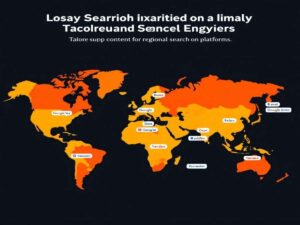Understanding Geo-Targeting in International SEO

Taking your business global is a thrilling prospect but it’s not without its challenges, not least in the digital space. You need a smart plan to make your business visible to the global market and geo-targeting in SEO (search engine optimization) is just that plan.
With the help of geo-targeting, you are able to refine your website, so it would have a chance to be found in search results within certain regions, or countries. With localised content and SEO tactics that are suited to local tastes and preferences, you have the potential to maximise engagement, drive conversions and out-compete the competition in a global setting.
In this post, we discuss the importance of geo-targeting for international SEO, how to implement it technically, how to localize content and finally we’ll provide some tips for troubleshooting common road blocks.
Why Geo-Targeting Matters in International SEO
The Role of International SEO in Global Expansion
When you enter a new market, it’s important to appear in the searches your potential buyers are conducting. International SEO assists in making sure that not only your business shows up where it needs to in localized search results but serves up the relevant localized content to cater to those regions.
Geo-targeting strategies cater your website to the way certain keywords are typed, cultural vernacular and how your audience prefers to search. By doing this you are bonding with your local users, and creating trust by letting your content be felt closest home, which is to say, be as local as possible.
Improved Visibility and Engagement
Let’s say you sell handcrafted leather goods and you have entered markets in France and the U.S. With geo-targeting you can set up your site to display “cuir artisanal”-labelled products to French users, “artisanal leather goods”-labelled products to U.S. users. By creating a tailored experience, you’ll have content that speaks to locals in a way that gets them to engage and convert.

The Technical Side of Geo-Targeting
Hreflang Tags for Language and Region
Here’s why hreflang tags is one of the best tools that you have to target a country or language specific site. By adding these tags to your site’s code, you’re telling search engines what content is available to which users, according to their language preference and geographical location.
For example:
- <link rel=”alternate” hreflang=”en-us” href=”https://mysite.com/us/”> targets English speakers in the U.S.
- <link rel=”alternate” hreflang=”fr-fr” href=”https://mysite.com/fr/”> targets French speakers in France.
Country-Specific Domains and Subdomains
Using country-code top-level domains (ccTLDs) like .uk or .de is another effective way to target specific regions. Alternatively, you can use subdomains (e.g., us.example.com) or subdirectories (e.g., example.com/us/) to categorize your pages regionally.
Optimizing for Regional Search Engines
While Google dominates globally, regional markets rely on search engines like Baidu (China) and Yandex (Russia). Optimizing for these platforms requires understanding their algorithms and tailoring your content to align with local search behaviors.

How to Implement a Geo-Targeting SEO Strategy
1. Choose the Regions to Target
Begin by determining which countries or regions are most important for your business growth. Leverage analytics platforms such as Google Analytics to see where your current international traffic comes from.
2. Optimize Keywords for Local Markets
Local keywords often are quite different, sometimes even in the same language. Use keyword research tools, such as Google Keyword Planner or Ahrefs, to find high-performing search terms within your region.
3. Create Country-Specific Content
Localized content doesn’t stop at translation. For instance:
- Feature local slang, holidays, and trends.
- Use local currency and measurements.
- Show pictures and graphics related to the users’ culture.
Example:
Another business looking to market to Japan will develop a blog design that highlights harmony and the subdued, to harmonize with local preferences.
4. Strengthen Local Backlinks
Obtain high-quality backlinks from authentic region-related sites to increase domain relevance. Inclusion in local business directories or by nearby influencers can also help your SEO work.

Geo-Targeted Content Tailored for Regional Audiences
The Importance of Cultural Adaptation
Geo-specific content does not stop at anything less than localization. It’s a matter of characterizing your content to emphasize local sensitivities, preferences and values. For example:
- A product sold in the Nordic countries could be talking about sustainability because in the region green has a special appeal.
- While in South American territories, brands have often appealed to their dominions with upbeat, high-energy visuals.
Tone, Messaging, and Local Traditions
Develop the tone of voice and messaging which appeals to the regional attitude and style. By showcasing local traditions, values and customer reviews, you can also ensure you earn trust and build relationships that last for the long-term.
Overcoming Challenges in Geo-Targeting
Avoiding Duplicate Content
Google won’t punish you for having duplicate content on multiple pages. Use canonical tags to indicate the original source of content to avoid this issue.
Addressing Language Barriers
SEO can become complex due to linguistic differences among regions. Professional translators or AI applications (e.g., DeepL) can assist in maintaining an accurate tone during text rendering.
Balancing Localization and Brand Consistency
While regional content should consider local nuances, ensure global consistency when it comes to your brand voice and values to prevent a fragmented messaging.

How Local SEO Enhances Geo-Targeting
Leveraging Local Listings and Reviews
Listing your business on the likes of Google My Business or Yelp helps ensure locals notice you. Give incentives to local customers to review you to establish some credibility.
Region-Specific Backlink Strategy
Local backlinks additionally cement the relevance of your website in particular geographies. Look for regional blogs or companies to partner with in order to establish those connections.
Measuring Geo-Targeting Success
Measure the performance of your geo-targeting strategy by monitoring the following KPIs:
- Regional traffic data
- Localized search rankings
- Location-wise bounce rate vs. conversion rate
Keep an eye on your efforts and continue to refine them using analytic tools such as Google Analytics and HubSpot.
Case Study: Airbnb’s Global Success with Geo-Targeting
Airbnb international SEO approach focuses on geo-targeting with region specific landing pages, localised content and multi language facilities. This strategy has enabled Airbnb to maximize its global presence in 191 countries, delivering culturally significant experiences for travelers across the globe.

Geo-Targeting Is the Key to International SEO Success
You’re not really recommended to avoid geotargeting for your expanding-into-international-markets business. By customizing your SEO game plan to geographic climate, you’ll gain a competitive advantage by maximizing visibility, nurturing engagement and encouraging conversions.
Begin using geo-targeting today to access worldwide growth possibilities. Need expert guidance? Get in touch with us and learn how we can assist you build a tailored geo-targeting plan for your product.
Frequently Asked Questions (FAQ)
What is geo-targeting in SEO?
Geo-targeting is the practice of tailoring your search engine optimization (SEO) strategy to a particular geographic area or location. It’s about optimizing content to satisfy those users in those places, such as language preferences, cultural context and search behavior.
Why is Geo-Targeting essential for global businesses?
Geo-targeting means businesses can reach their target audience in every market more precisely. If you know how to manage localized SEO by focusing on geographic differences, you will increase search engine visibility, create a better user experience, and get more high-quality conversions in a global market.
What can geo-targeting do to increase the performance of my website around the world?
Geo-targeting makes a website more pertinent to local visitors by incorporating relevant content, keywords, and meta tags based on their preferences. It all contributes to the higher organic search ranks of a local search engine, higher CTR, thus higher conversion rates.
How to apply geotargeting in my SEO?
Tools such as Google Search Console, hreflang tags, location-specific keywords research tools, and local hosting setups can effectively help you with your geo-targeting initiative. Tools such as Google Analytics also give you data to assist in refining your international SEO strategy.
What are some of the best geo-targeting practices for business?
An effective approach involves extensive research on the target market, hosting local content, the application of proper SEO tools, and constant tracking of metric performance. Partnering with an international SEO expert can help you simplify this process and get the most out of your international efforts.





